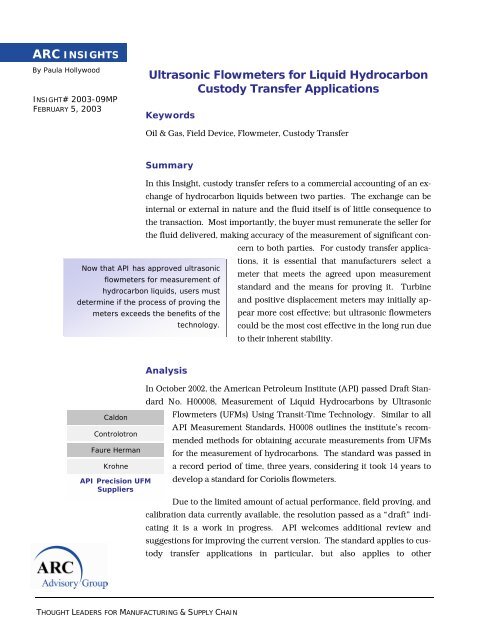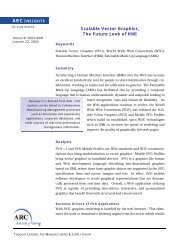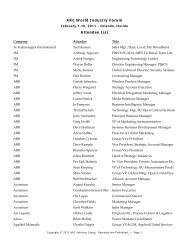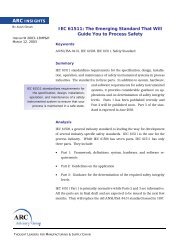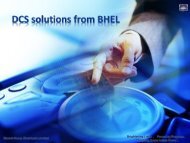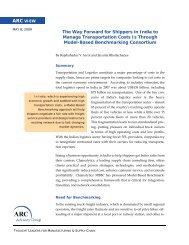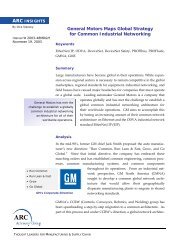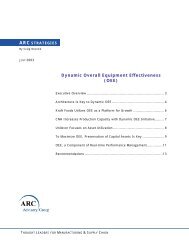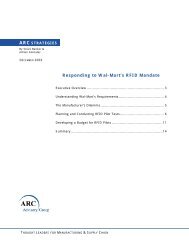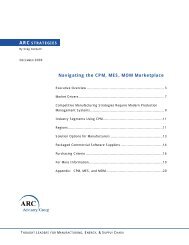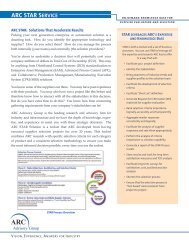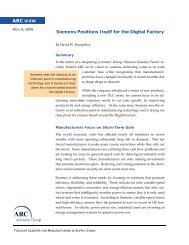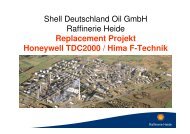Ultrasonic Flowmeters for Liquid Hydrocarbon Custody Transfer ...
Ultrasonic Flowmeters for Liquid Hydrocarbon Custody Transfer ...
Ultrasonic Flowmeters for Liquid Hydrocarbon Custody Transfer ...
Create successful ePaper yourself
Turn your PDF publications into a flip-book with our unique Google optimized e-Paper software.
ARC INSIGHTS<br />
By Paula Hollywood<br />
INSIGHT# 2003-09MP<br />
FEBRUARY 5, 2003<br />
<strong>Ultrasonic</strong> <strong>Flowmeters</strong> <strong>for</strong> <strong>Liquid</strong> <strong>Hydrocarbon</strong><br />
<strong>Custody</strong> <strong>Transfer</strong> Applications<br />
Keywords<br />
Oil & Gas, Field Device, Flowmeter, <strong>Custody</strong> <strong>Transfer</strong><br />
Summary<br />
In this Insight, custody transfer refers to a commercial accounting of an exchange<br />
of hydrocarbon liquids between two parties. The exchange can be<br />
internal or external in nature and the fluid itself is of little consequence to<br />
the transaction. Most importantly, the buyer must remunerate the seller <strong>for</strong><br />
the fluid delivered, making accuracy of the measurement of significant concern<br />
to both parties. For custody transfer applications,<br />
it is essential that manufacturers select a<br />
Now that API has approved ultrasonic<br />
meter that meets the agreed upon measurement<br />
flowmeters <strong>for</strong> measurement of<br />
standard and the means <strong>for</strong> proving it. Turbine<br />
hydrocarbon liquids, users must<br />
determine if the process of proving the and positive displacement meters may initially appear<br />
more cost effective; but ultrasonic flowmeters<br />
meters exceeds the benefits of the<br />
technology. could be the most cost effective in the long run due<br />
to their inherent stability.<br />
Caldon<br />
Controlotron<br />
Faure Herman<br />
Krohne<br />
API Precision UFM<br />
Suppliers<br />
Analysis<br />
In October 2002, the American Petroleum Institute (API) passed Draft Standard<br />
No. H00008, Measurement of <strong>Liquid</strong> <strong>Hydrocarbon</strong>s by <strong>Ultrasonic</strong><br />
<strong>Flowmeters</strong> (UFMs) Using Transit-Time Technology. Similar to all<br />
API Measurement Standards, H0008 outlines the institute’s recommended<br />
methods <strong>for</strong> obtaining accurate measurements from UFMs<br />
<strong>for</strong> the measurement of hydrocarbons. The standard was passed in<br />
a record period of time, three years, considering it took 14 years to<br />
develop a standard <strong>for</strong> Coriolis flowmeters.<br />
Due to the limited amount of actual per<strong>for</strong>mance, field proving, and<br />
calibration data currently available, the resolution passed as a “draft” indicating<br />
it is a work in progress. API welcomes additional review and<br />
suggestions <strong>for</strong> improving the current version. The standard applies to custody<br />
transfer applications in particular, but also applies to other<br />
THOUGHT LEADERS FOR MANUFACTURING & SUPPLY CHAIN
ARC Insights, Page 2<br />
applications, such as allocation, check metering, and leak detection. Only<br />
spool-type meters having two or more paths with permanently affixed<br />
transducers are acceptable such that samples can be taken along multiple<br />
acoustic paths. Excluded are meters having clamp-on style transducers due<br />
to the potential ease with which the transducers could become dislodged<br />
from their original mounting position. Naturally this approval makes suppliers<br />
of such UFMs very happy, but what does it mean <strong>for</strong> manufacturers?<br />
Proving Meter Certainty<br />
The minimum requirement <strong>for</strong> fiscal measurement is a high degree of accuracy.<br />
If a regulatory body is involved, statutory requirements generally<br />
become much more stringent. An accepted practice of verifying meter<br />
measurement is comparing a known prover volume to an indicated meter<br />
volume. In addition to mandatory requirements <strong>for</strong> proving mandated by<br />
regulatory agencies and/or standards organizations, other valid reasons<br />
include:<br />
CAUSE<br />
Hydraulic distortion of flow<br />
profile<br />
Meter accuracy<br />
Variations in fluid properties<br />
i.e. viscosity<br />
Maintenance required<br />
EFFECT<br />
Removes effect of installation hydraulics on<br />
flow profile<br />
Provides verification<br />
Eliminates variation<br />
Provides indication based on results<br />
Reasons <strong>for</strong> Proving <strong>Custody</strong> <strong>Transfer</strong> Meters<br />
Proving is the recommended method <strong>for</strong> validating meter repeatability and<br />
proving to API standards is common throughout the world. To ensure an<br />
accurate picture of meter per<strong>for</strong>mance API requires a minimum of 10,000<br />
meter pulses be obtained. Based on the assumption of a one pulse error<br />
each time a detector is passed, a possible error of 0.02 percent exists considering<br />
the proving system has a start and stop detector as in a pipe prover.<br />
The more traditional custody transfer measurement technologies such as<br />
turbines are mechanical in nature and can be proved in a relatively short<br />
number of proving runs, usually five, due to the inherent inertia of the rotor.<br />
The sampling methodology of UFMs produces a greater degree of data<br />
scatter due to the technology’s ability to measure minor variations in velocity<br />
thus producing a wider range of repeatability. Under these<br />
circumstances UFMs may require larger proof volumes and a greater num-<br />
©2003 • ARC • 3 Allied Drive • Dedham, MA 02026 USA • 781-471-1000 • ARCweb.com
ARC Insights, Page 3<br />
ber of proving runs to achieve the same uncertainty as a turbine or positive<br />
displacement meter. In actuality there is no difference in a repeatability<br />
range of 0.05% in 5 runs versus a range of 0.14% in 12 runs, meaning the<br />
operator can choose to increase the number of runs to account <strong>for</strong> the inherent<br />
proving variability of different suppliers. The standard is practical<br />
without affecting per<strong>for</strong>mance allowing operators to select up to 20 runs to<br />
meet repeatability standards.<br />
Volumetric Proving Methods<br />
There are three commonly accepted proving methods, the pipe or ball<br />
prover, the small volume or compact prover, and the master meter. All<br />
three methods have their own idiosyncrasies and it is up to the discretion of<br />
the user which method to use. Regardless of the selected method, good<br />
industry practice recommends proving be per<strong>for</strong>med with the flowmeter in<br />
place to account <strong>for</strong> any hydraulic effects on the installation.<br />
Stationery Pipe Prover<br />
Pipe Provers<br />
A pipe prover is a closed system generally consisting of a section of pipe of<br />
constant size in which a piston is moved along by the liquid to<br />
be measured. Meter pulses are counted as the piston moves between<br />
the start and stop detectors embedded in the pipe run.<br />
Because the volume between the detectors is known, the pulses<br />
per liter of product can be easily deduced. The advantage of<br />
pipe provers is continuous flow through the meter being calibrated.<br />
Bi-directional provers offer long term stability while unidirectional<br />
provers offer minimal pressure loss. Despite their<br />
large size, pipe provers will likely be the system of choice although<br />
their larger proof volume is necessary <strong>for</strong> reliable<br />
proving of ultrasonic flowmeters.<br />
Trailer Mounted SVP<br />
Small Volume Prover<br />
As the name implies, small volume provers (SVPs) are small in<br />
size and are sometimes referred to as compact or piston provers.<br />
To facilitate field calibrations, they can be made portable by<br />
mounting on a truck or trailer. In this fashion the prover is<br />
more useful across the plant and it becomes more economical<br />
than requiring a separate prover <strong>for</strong> each meter. In an SVP the<br />
displacer does not move freely as it is a piston connected to a<br />
piston rod. SVPs use a faster test cycle which minimizes prob-<br />
©2003 • ARC • 3 Allied Drive • Dedham, MA 02026 USA • 781-471-1000 • ARCweb.com
ARC Insights, Page 4<br />
lems associated with temperature stability. In order to ensure API’s recommended<br />
10,000 pulses per run, pulse interpolation is used to compensate<br />
<strong>for</strong> the relatively small volume of product displaced in this type of prover.<br />
Precise time determination and pulse counting provide high accuracy with<br />
fewer pulses. The small proof volume of compact provers limits its applicability<br />
to proving small ultrasonic meters in the plant and is unlikely to be<br />
used <strong>for</strong> larger custody transfer pipeline applications.<br />
Turbine Master Meters<br />
Master Meter<br />
Proving with a master meter involves using an alternate technology to<br />
prove repeatability using a meter whose calibration has been previously<br />
determined against a standard. This approach enables proving over any<br />
length of time. A turbine metering run, <strong>for</strong> instance, would be incorporated<br />
into the prover and calibrated on the specific process fluid. The output of<br />
the ultrasonic meter is then synchronized with the pulses<br />
from the turbine using the appropriate number of pulses to<br />
provide adequate repeatability. Master meters are seldom<br />
used <strong>for</strong> custody transfer applications since they may have<br />
the same inherent problems as the meters proved. The master<br />
meter adds another dimension of uncertainty to the<br />
system that must be accounted <strong>for</strong> however the overall size<br />
of the prover can be reduced.<br />
Recommendations<br />
• Oil industry users must decide if the benefits of ultrasonic technology<br />
<strong>for</strong> custody transfer applications outweigh any additional time and cost<br />
required to prove it according to the API standard. A cost-benefit<br />
analysis may be required to make this determination.<br />
• Suppliers need to lessen the burden of proof on their customers by developing<br />
more efficient proving methods.<br />
Please help us improve our deliverables to you – take our survey linked to this<br />
transmittal e-mail or at www.arcweb.com/myarc in the Client Area. For further<br />
in<strong>for</strong>mation, contact your account manager or the author at<br />
phollywood@arcweb.com. Recommended circulation: All MAS-P clients. ARC<br />
Insights are published and copyrighted by ARC Advisory Group. The in<strong>for</strong>mation<br />
is proprietary to ARC and no part of it may be reproduced without prior permission<br />
from ARC.<br />
©2003 • ARC • 3 Allied Drive • Dedham, MA 02026 USA • 781-471-1000 • ARCweb.com


